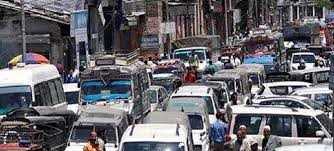
Traffic congestion on Juma-ul-Vida in Srinagar is a common issue. Juma-ul-Vida, being the last Friday of Ramadan, draws a large number of people to mosques, particularly in areas like the Jamia Masjid, and other popular prayer sites. This leads to a significant influx of vehicles and pedestrians, which often causes severe traffic jams throughout the city.
The key reasons for traffic congestion during Juma-ul-Vida in Srinagar include:
Many people from across the city and even from surrounding areas come to offer prayers, which increases the footfall and leads to heavy vehicle and pedestrian movement.
To manage the large crowds, traffic authorities sometimes close certain roads or divert traffic to alternate routes. This, while necessary for safety, can lead to bottlenecks.
Many areas of Srinagar have narrow streets that were not designed to handle the volume of traffic that comes during such significant occasions.
Since it’s also a day when people shop for Eid, local markets around mosques and important areas see high foot traffic, further complicating movement for both pedestrians and vehicles.
These factors combined result in longer travel times, frustration for commuters, and delays throughout the city. Authorities often try to manage the traffic flow, but the sheer number of people involved can still lead to significant congestion.
Were you affected by the traffic, or was it something you noticed from reports?
Traffic congestion on Juma-ul-Vida in Srinagar is a common issue. Juma-ul-Vida, being the last Friday of Ramadan, draws a large number of people to mosques, particularly in areas like the Jamia Masjid, and other popular prayer sites. This leads to a significant influx of vehicles and pedestrians, which often causes severe traffic jams throughout the city.
The key reasons for traffic congestion during Juma-ul-Vida in Srinagar include:
Many people from across the city and even from surrounding areas come to offer prayers, which increases the footfall and leads to heavy vehicle and pedestrian movement.
To manage the large crowds, traffic authorities sometimes close certain roads or divert traffic to alternate routes. This, while necessary for safety, can lead to bottlenecks.
Many areas of Srinagar have narrow streets that were not designed to handle the volume of traffic that comes during such significant occasions.
Since it’s also a day when people shop for Eid, local markets around mosques and important areas see high foot traffic, further complicating movement for both pedestrians and vehicles.
These factors combined result in longer travel times, frustration for commuters, and delays throughout the city. Authorities often try to manage the traffic flow, but the sheer number of people involved can still lead to significant congestion.
Were you affected by the traffic, or was it something you noticed from reports?
© Copyright 2023 brighterkashmir.com All Rights Reserved. Quantum Technologies